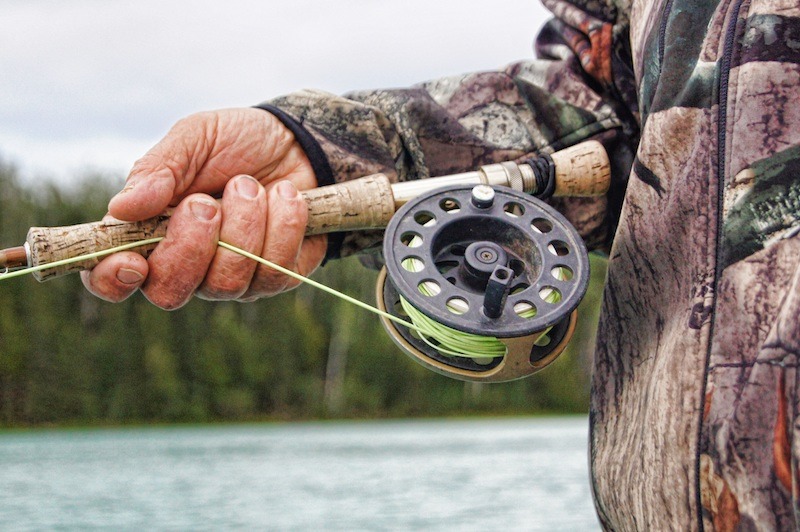
I’m a nymph guy. I admit it. Some guys are dry fly guys, some are streamer guys; I’m a nymph guy. I’ve come to be this way after years of fishing. I like to leech as well, but I love to nymph, especially in lakes. I’ve found that over the years I take about 40% of my fish on leeches and 40% on nymphs. The other 20% are taken on dries and chironomids. I get the biggest kick from persuading a fish to strike at a dry fly, as do most fly-fishers, but next to that I love to fool a fish into thinking my nymph pattern is actually trout food.
In becoming a practicing nymph guy I tried tying my nymph patterns from a plethora of different materials, including synthetics, plastics, epoxy, foam, wool, feathers, and fur. I’ve tied them in bright colours and dull colours, mixed backward and forwards, used palmered hackle, beards, splayed hackle and quill for legs and swimmerets. I’ve used curved hooks and straight hooks. If I could give you advice on tying and fishing nymphs based upon my experiences I would tell you this: there are four keys to consistent success (and you may have heard this before): size, shape, colour, and motion. This is not a new concept. In fact, this is a very old concept. The reason I restate it here is that sometimes it takes years to learn that what was true in the past is still true today. Let’s talk a bit about this concept of matching the naturals.
Fish are creatures of habit and instinct. To them, whatever moves in the water is potential food. If it looks like something they have eaten before, then it is food and they will eat it again. Thus a florescent green nymph may not catch a fish, but an olive one tied the same will (all other things being equal). During hatches, this becomes especially true. Fish key in on specific species of insects and become very particular; they exhibit the classic fussy fish syndrome. To be successful at any time, but especially at these times, you have to figure out what they are eating. Rummage through shoreline detritus, look under rocks and logs or examine the stomach contents of a fish to see what is available and what the fish are feeding on. It’s easy when the fish are onto adults during a hatch, but not so easy when they are feeding subsurface.
Once you have figured out what the fish are eating, you should match it as best you can by size, shape and colour, in that order. This is key. The fourth point, however, is often ignored by fly-fishers, much to their demise. Accurately imitating the movement of the nymph is critical to being consistently successful. To get it right you must observe the insects in the water. Some swim at a steady pace, some pulse, some wiggle like a worm, some crawl and some just drift in the current or lie on the bottom and don’t move at all.
“So how do I get my artificial to move like the natural?” you ask. The answer lies in the combination of materials and retrieve.
Nymphs that swim or crawl at a steady pace are easily imitated. Your fly can be tied out of pretty much any material you want, and a hand-twist retrieve is used to move it along. People often make the mistake of strip retrieving flies like a damsel nymph and they don’t do as well as those who hand-twist. Insects that wiggle when they swim should be imitated by using soft, flowing materials during the tying process. Marabou works well in such cases, and the most productive damselfly nymph imitations all incorporate marabou. Insects like the caddis pupa pulse when they swim so try tying the long swimmeret legs from rubber or soft pheasant tail fibres and sharply strip retrieving the fly to get that pulsing motion. Another material that I have found useful in imitating certain nymphs is plastic lace. Wire is usually used to create a rib and give the illusion of a segmented body to the fly, but I have found that plastic lace does a much better job. I have often used Larva Lace for this purpose, but the best lace for this purpose is the oil filled Liquid Lace. It is actually a hollow tube, and you fill the middle with mineral oil. Not only does it create beautifully segmented bodies, but the mineral oil centre produces a translucence that is highly attractive to fish. Check it out at www.uniqueflyfishing.com. With a bit of forethought into how you design and fish your nymphs, you can improve your fishing success significantly and it won’t take long before you will become an accomplished amateur aquatic entomologist and a nymph guy too.
Visit the Store
$34.99
$34.99
Featured Catch

Joel Unickow halibut (Photo: Rob Frawley Lucky Strike Sportfishing Tofino)







